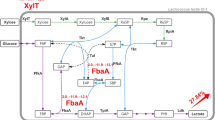Abstract.
In lactic acid bacteria, pentoses are metabolized via the phosphoketolase pathway, which catalyzes the cleavage of D-xylulose-5-phosphate to equimolar amounts of glyceraldehyde 3-phosphate and acetylphosphate. Hence the yield coefficient of lactate from pentose does not exceed 1.0 mol/mol, while that of Lactococcus lactis IO-1(JCM7638) at high D-xylose concentrations often exceeds the theoretical value. This suggests that, in addition to the phosphoketolase pathway, L. lactis IO-1 may possess another metabolic pathway that produces only lactic acid from xylose. In the present study, the metabolism of xylose in L. lactis IO-1 was deduced from the product formation and enzyme activities of L. lactis IO-1 in batch culture and continuous culture. During cultivation with xylose concentrations above ca. 50 g/l, the yield coefficient of L-lactate exceeded 1.0 mol/mol while those of acetate, formate and ethanol were very low. At xylose concentrations less than 5 g/l, acetate, formate and ethanol were produced with yield coefficients of about 1.0 mol/mol, while L-lactate was scarcely produced. In cells grown at high xylose concentrations, a marked decrease in the specific activities of phosphoketolase and pyruvate formate lyase (PFL), and an increase in those of transketolase and transaldolase were observed. These results indicate that in L. lactis IO-1 xylose may be catabolized by two different pathways, the phosphoketolase pathway yielding acetate, formate and ethanol, and the pentose phosphate (PP)/glycolytic pathway which converts xylose to L-lactate only. Furthermore, it was deduced that the change in the xylose concentration in the culture medium shifts xylulose 5-phosphate metabolism between the phosphoketolase pathway and the PP/glycolytic pathway in L. lactis IO-1, and pyruvate metabolism between cleavage to acetyl-CoA and formic acid by PFL and the reduction to L-lactate by lactate dehydrogenase.
Similar content being viewed by others

Author information
Authors and Affiliations
Additional information
Electronic Publication
Rights and permissions
About this article
Cite this article
Tanaka, .K., Komiyama, .A., Sonomoto, .K. et al. Two different pathways for D-xylose metabolism and the effect of xylose concentration on the yield coefficient of L-lactate in mixed-acid fermentation by the lactic acid bacterium Lactococcus lactis IO-1. Appl Microbiol Biotechnol 60, 160–167 (2002). https://doi.org/10.1007/s00253-002-1078-5
Received:
Revised:
Accepted:
Issue Date:
DOI: https://doi.org/10.1007/s00253-002-1078-5



